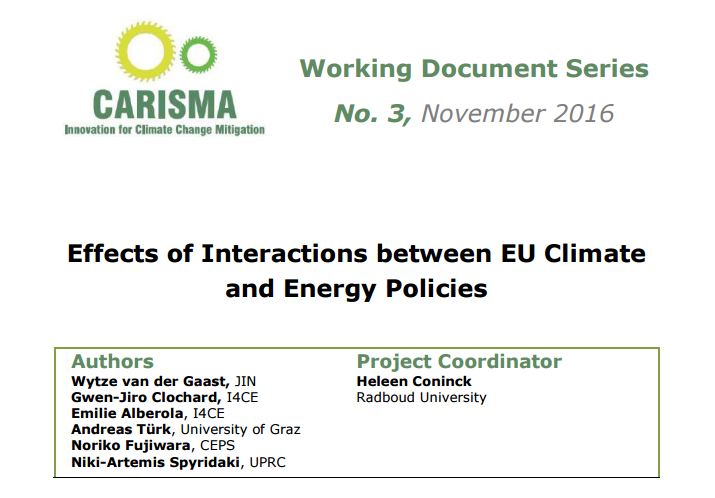Interactions between EU climate and energy policies have been analysed based on France, Austria, Greece, and EU-level for policy interaction examples. The analysis resulted in 6 main findings.
This report contains case studies of environmental and climate change policy making with a specific focus on how the results of chosen policies have been influenced by other policies. The reason for focusing on policy interactions is the realisation that policy making takes place within complex systems, where stakeholders are confronted with multiple other policies. Should policy making take place in isolation from other policies, policy makers could use their best available knowledge of the efficacy of policy instruments to achieve a policy target, given the assumed response of targeted stakeholders to these instruments. In the real world, however, policies are formulated and implemented in a complex environment where multiple climate, environmental and energy policies co-exist.

In this report, interactions between EU climate and energy policies have been analysed based on four case studies:
- France: Impact of the implementation of the RED and energy efficiency measures on GHG emissions in in the electricity sector under the EU ETS.
- Austria: Interaction between energy efficiency policy measures at the levels of the federal and regional governments.
- Greece: Impact of the planned Energy Efficiency Obligation scheme in Greece on the GHG emissions in the Greek power sector covered by the EU ETS.
- EU-level: Implications of interaction between the EU ETS and the Renewable Energy Directive.
Together, the case studies provide an illustrative pallet of policy interaction examples, while it is acknowledged that the overview should not be considered fully representative for all types of policy interactions that may occur because of implementation of the Energy and Climate Package in the EU and the Member States
The analysis resulted in the following main findings.
- Consistency between policies during policy design stages: Policy interaction can take place through policies’ overarching objectives, policy instruments (to achieve policy objectives) and their design characteristics (target, scope, technologies, and target groups). Policy co-existence can be justified if the policies are aimed at different targets, such as one policy to achieve short-term environmental targets and another policy for longer-term targets. Policies can be considered consistent when individual policy instruments do not contradict each other, but instead, result in synergies within the policy mix. To avoid negative interactions, it is therefore important that ex ante impact assessments of policies consider potential interactions and ensure that they all work in the same ‘direction’.
- Have provisions in place in case the effects of policy interactions are not anticipated or stronger than anticipated: There can be cases in practice where a specific policy interaction is assumed to lead to synergistic effects (e.g., policies all contribute to CO2 emission reduction), but that actual practice shows that the policy results are undesirable. For example, the EU-level and Greek case studies on interaction between ETS and renewable energy support and ETS and the energy efficiency obligation scheme, respectively, has shown that accelerated deployment of renewable energy technologies has resulted in extra CO2 emission reductions, larger EUA surpluses and a lower EUA price. While beforehand, these effects were expected, the impacts of the economic crisis after 2008 on the ETS market were not anticipated. Consequently, market imbalances could not be repaired. Quantity management solutions, such as the ETS Market Stability Reserve (EU case study) or price floors (French case study) can serve as a solution for that.
- Streamline and fine tune policy making at different policy making levels within countries: While most of the case studies focus on interactions between different policy instruments covering different policy areas (i.e. energy efficiency, renewable energy and climate), the case study in Austria has shown an example of policy interactions taking place within one policy area but between federal and provincial levels of government, which both, quite independently from each other, operate subsidy schemes for energy efficiency improvements in households. The case study has shown that Austria’s energy consumption in households decreased over the last years, which is likely to be attributable to energy efficiency measures at different government levels. However, it also raises the question of how efficient the current policy mix has been and whether there is a need to reform the current system towards a policy mix that is not entirely based on subsidies. One potential issue, which has been mentioned in the Austrian case study, is that more efficient federal and provincial mixes of energy efficiency policies may require termination or changing some of the subsidies. At the same time, subsidies have the largest political acceptance among policy instruments in the country, which may require a trade-off between policy efficiency and acceptance.
- Renewable energy targets formulated as percentages can ‘automatically’ be achieved because of energy efficiency policies: The French case study shows how renewable energy targets were ‘automatically’ met because of achieving energy efficiency goals. Due to energy efficiency measures, energy consumption reduced, so that renewable energy goals, formulated as a percentage of energy consumption, were automatically met. While this is no problem for short-term policy goals, this interaction reduces the pressure to increase investments in renewable energy technologies, which may be detrimental for development of technologies needed for future energy and climate goals. To mitigate this, renewable energy targets can be set as absolute amounts of renewable energy to be produced/consumed.
- Impact of policy interactions partly depends on (energy) market characteristics: The case study in Greece has shown how a monopoly situation in the electricity market can lead to a passing on to consumers of increasing compliance costs due to the combined effect of the energy efficiency obligation and ETS schemes for energy producers. The case study in France has demonstrated that interaction between national renewable energy support policies and the EU ETS is much weaker as in other Member States, especially compared to Germany, as the French power sector has a relatively small CO2-intensity so that national policies are likely to have a negligible impact on the EU ETS (in terms of surpluses and prices).
- Short-term interactions between EU ETS and renewable energy policies may result in negative impact on renewable energy technology deployment in the longer term: The case studies illustrate how short-term interactions may have negative impacts on achieving long-term energy and climate targets. Case study examples of energy efficiency and ETS, as well as renewable energy and ETS policy interactions have shown that in general CO2 emissions decrease, but the lower prices for EU allowances may postpone investments in low-emission technologies. This may jeopardise the attainment of long-term GHG emission targets and implicitly put off R&D efforts in more efficient low emission technologies.
The Working Document can be downloaded here.

CARISMA
CARISMA project
Project details
- Project title: “Coordination and Assessment of Research and Innovation in Support of climate Mitigation Actions” (CARISMA)
- Funding scheme: European Union Horizon 2020 Programme (EU H2020, grant agreement no. 642242)
- Duration: 3.5 years (1 February 2015 – 31 July 2018)
- Project coordinator: Radboud University, Nijmegen, the Netherlands
- Project website: www.carisma-project.eu


